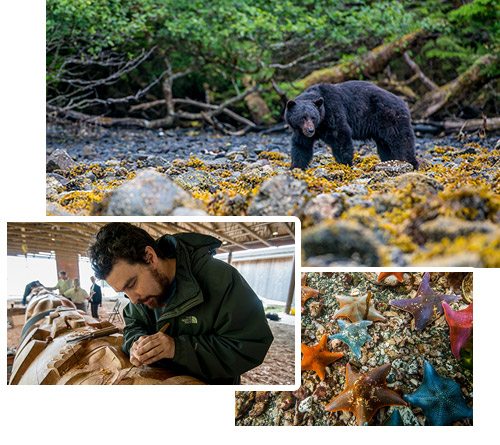WEST COAST
Federal ecozone: Pacific Maritime
Area: 207,445 km2
Natural cover: 205,201 km2
Per cent natural: 99%
Protected area: 47,772 km2
Per cent protected: 23%
Number of NCC projects (all): 78
Number of species of birds: 303
Number of species of trees: 57
Number of species of mammals: 116
Number of species of amphibians: 16
Estimated human population: 4,011,232

Description
Canada’s West Coast extends along the Pacific Ocean, from Vancouver and Vancouver Island north to Haida Gwaii and the Alaskan Panhandle. This is a region where land, fresh water and sea are integrated to form unique habitats and spectacular landscapes. Spanning from kelp beds on the ocean floor to the peaks of the Coastal Mountains, it has the highest diversity of species and habitats in Canada. The fog and heavy rains in the region, resulting from warmer ocean air meeting cool air flowing down from the mountains, create optimal growing conditions.
West Coast Landscape

Conservation values
The West Coast is one of the few places left in the world with healthy populations of carnivores, including grizzly bear, grey wolf, cougar and the rare white form of the American black bear, often referred to as the spirit bear. Other wildlife includes black-tailed deer and bald eagle.
Pacific salmon are a key species in the West Coast. Every year, tens of millions of salmon return to the rivers where they were born to spawn and to die. This annual migration provides important food for bear, wolves and other wildlife, and provides important nutrients to the forest. Wild, undammed rivers are still common in parts of this region, with the Nass, Dean, Bella Coola, Wannock and Klinaklini rivers free-flowing from mountain glaciers to the sea.
The region supports an abundance of other marine wildlife. Many seabirds, including the marbled murrelet and tufted puffin, nest along the coast, and millions of seabirds and waterfowl migrate along the coast. Marine mammals include the northern sea lion, northern fur seal, harbour seal, killer whale and sea otter.
Challenges/Threats
Eighty per cent of BC’s population lives along the West Coast, mostly in Metro Vancouver and the Fraser Valley, Greater Victoria, Nanaimo and other portions of southeast Vancouver Island. Key issues in this region include residential and industrial development, unsustainable forestry, and the impacts of climate change, including rising sea levels.
What NCC is doing
NCC has identified priority conservation sites in a number of natural areas, including:
- Central Coast Rainforest
- Clayoquot Sound
- Haida Gwaii
- Salish Sea

Did you know?
- The West Coast includes the world’s largest remaining tracts of temperate rainforest.
- The tallest trees in Canada occur here, including a 96-metre-tall Sitka spruce in Youbou and a 94-metre-tall Douglas-fir in Coquitlam.
- Several tree species can live to 1,000 years old, and yellow cedar can live for nearly 2,000 years.
- The decaying and living trees of the temperate rainforest contain more living biomass than any ecosystem on Earth.
- The southernmost region of the West Coast includes some of Canada’s most endangered habitats: Garry oak savannah and dry coastal Douglas-fir ecosystems. Today, less than one per cent of old-growth coastal Douglas-fir forests still stand, and less than five per cent of Garry oak ecosystems persist in a near natural condition.
Photo Credits (Top to bottom): All images by Neil Ever Osborne.
